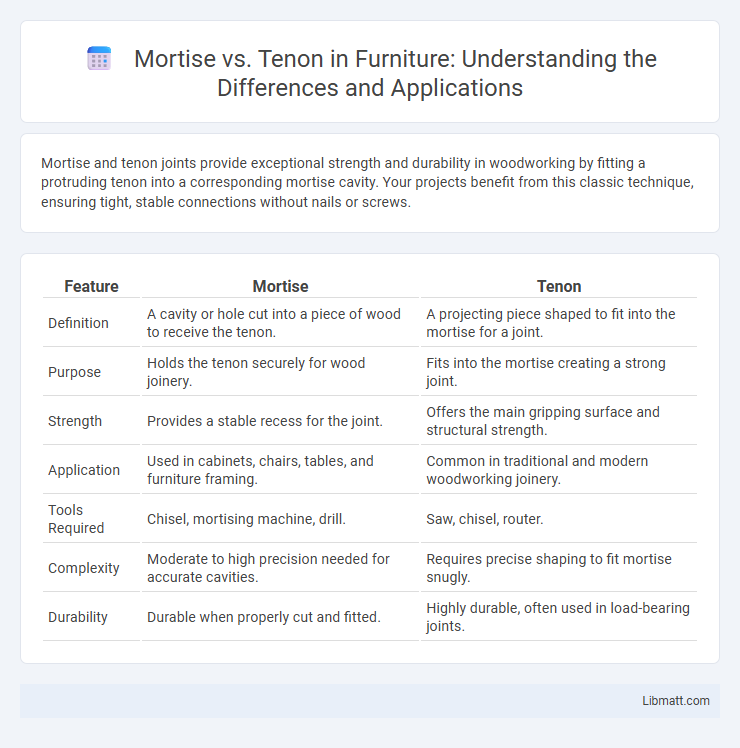Mortise and tenon joints provide exceptional strength and durability in woodworking by fitting a protruding tenon into a corresponding mortise cavity. Your projects benefit from this classic technique, ensuring tight, stable connections without nails or screws.
Table of Comparison
| Feature | Mortise | Tenon |
|---|---|---|
| Definition | A cavity or hole cut into a piece of wood to receive the tenon. | A projecting piece shaped to fit into the mortise for a joint. |
| Purpose | Holds the tenon securely for wood joinery. | Fits into the mortise creating a strong joint. |
| Strength | Provides a stable recess for the joint. | Offers the main gripping surface and structural strength. |
| Application | Used in cabinets, chairs, tables, and furniture framing. | Common in traditional and modern woodworking joinery. |
| Tools Required | Chisel, mortising machine, drill. | Saw, chisel, router. |
| Complexity | Moderate to high precision needed for accurate cavities. | Requires precise shaping to fit mortise snugly. |
| Durability | Durable when properly cut and fitted. | Highly durable, often used in load-bearing joints. |
Introduction to Mortise and Tenon
Mortise and tenon is a traditional woodworking joint used to connect two pieces of wood at a 90-degree angle, known for its strength and durability. The mortise is a cavity or hole cut into one piece, while the tenon is a corresponding projection on the other piece that fits snugly into the mortise. This joint is commonly used in furniture making, cabinetry, and timber framing for its reliability and resistance to tension and shear forces.
What is a Mortise?
A mortise is a rectangular or square cavity cut into a piece of wood to receive a corresponding tenon for a secure joint. This precise cavity is essential in traditional woodworking, providing strength and alignment by fitting the tenon snugly. Mortise dimensions vary based on project requirements but must be cleanly chiseled or routed for an effective joint.
What is a Tenon?
A tenon is a rectangular projection at the end of a piece of wood designed to fit snugly into a corresponding mortise, forming a strong, interlocking joint widely used in woodworking and furniture construction. This precise fit provides excellent mechanical strength and stability without the need for nails or screws. Understanding your tenon's size and shape is essential for creating durable joints that enhance the structural integrity of your projects.
Key Differences Between Mortise and Tenon
Mortise and tenon joints differ primarily in their structure and application; the mortise is a rectangular cavity cut into one piece of wood, while the tenon is a projecting tongue on the end of another piece designed to fit snugly into the mortise. This traditional woodworking technique ensures a strong, durable connection without the need for metal fasteners, making it ideal for furniture and timber framing. The precision of the fit between mortise and tenon affects the joint's strength and longevity, highlighting the importance of careful measurement and crafting in joinery.
Historical Significance of Mortise and Tenon Joints
Mortise and tenon joints have been a cornerstone in woodworking since ancient Egypt, where they were used in constructing temples and furniture, demonstrating durability and precision. This joint technique was pivotal in medieval timber framing, enabling the creation of stable structures like cathedrals and castles without nails or adhesives. Its enduring historical significance lies in its simplicity, strength, and adaptability, influencing woodworking craftsmanship and architectural design for thousands of years.
Common Applications in Modern Woodworking
Mortise and tenon joints are widely used in modern woodworking for constructing furniture, such as chairs, tables, and cabinets, due to their strength and durability. This joint provides excellent resistance to twisting forces, making it ideal for load-bearing frames and structural components in wooden doors and window frameworks. Advanced woodworking techniques often incorporate mortise and tenon joints in high-end cabinetry and custom woodwork to ensure long-lasting, precise fits.
Pros and Cons of Mortise and Tenon Joints
Mortise and tenon joints offer exceptional strength and durability, making them ideal for load-bearing furniture and woodworking projects. The mortise provides a secure cavity, while the tenon fits snugly, resulting in a joint resistant to twisting and pulling forces; however, crafting these joints requires precise skill and can be time-consuming. Your choice depends on the balance between the superior stability needed and the complexity involved in creating these traditional, long-lasting connections.
Alternatives to Mortise and Tenon Connections
Alternatives to mortise and tenon connections include dowel joints, which use cylindrical wooden pins to align and reinforce the joint, providing a quicker assembly option. Pocket hole joinery offers another efficient method, utilizing angled screws to join pieces without visible hardware, making it popular for cabinetry and furniture. Biscuit joints employ oval-shaped wooden biscuits inserted into slots, expanding with glue to create a strong bond ideal for panel alignment and edge joining.
Tips for Strong Mortise and Tenon Joinery
Ensure precise measurements when cutting both the mortise and tenon to achieve a snug fit that prevents wobbling. Use sharp chisels and appropriate tools for clean edges and smooth surfaces, enhancing glue adhesion and structural integrity. Apply high-quality wood glue evenly in the joint, clamp securely during drying, and consider reinforcing with pins or wedges for added strength in mortise and tenon joinery.
Conclusion: Choosing the Right Joint for Your Project
Mortise and tenon joints offer exceptional strength and durability, making them ideal for furniture and structural woodwork. The mortise provides a precise socket, while the tenon fits snugly, ensuring a tight and long-lasting connection suitable for load-bearing applications. Selecting the right joint depends on project requirements, wood type, and desired aesthetic, with mortise and tenon excelling in traditional craftsmanship and heavy-duty assemblies.
Mortise vs tenon Infographic

 libmatt.com
libmatt.com